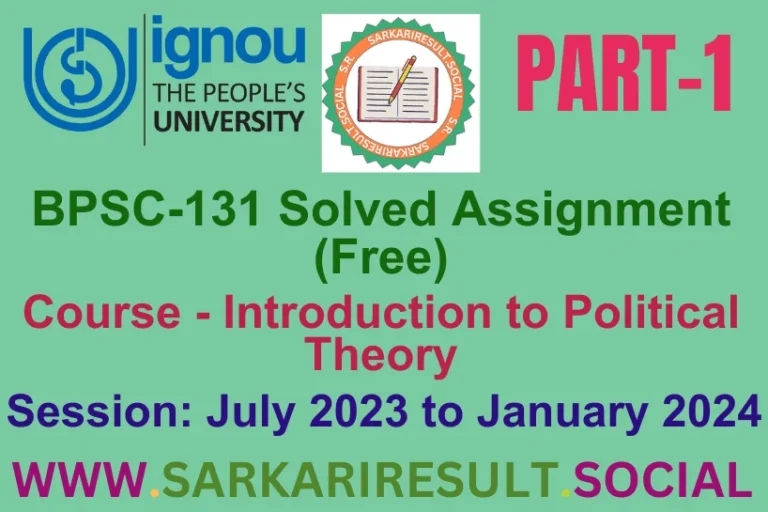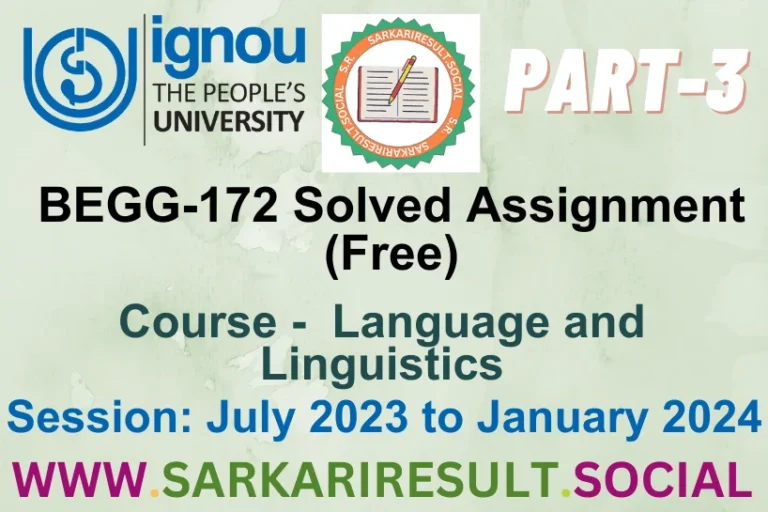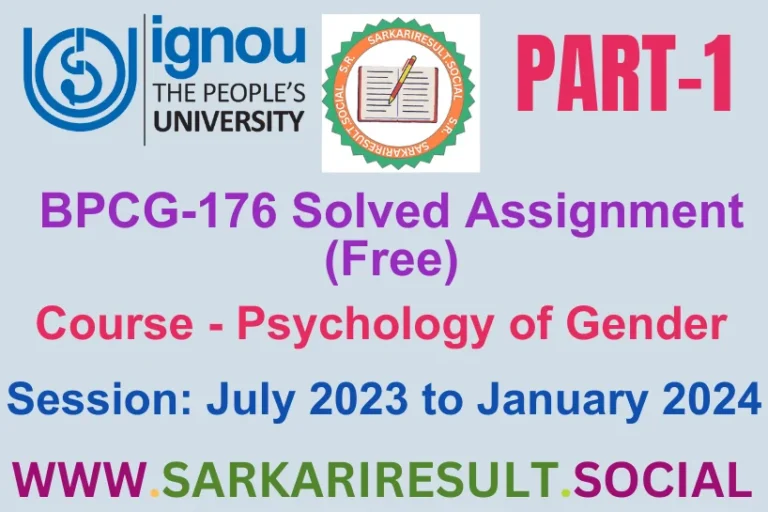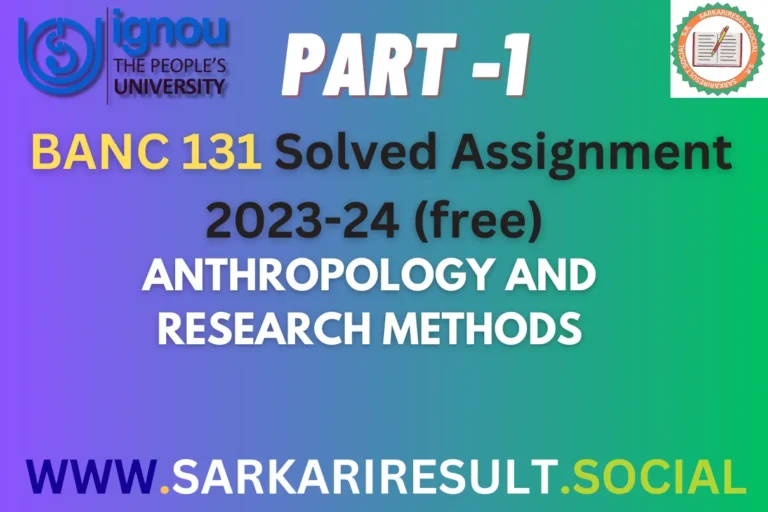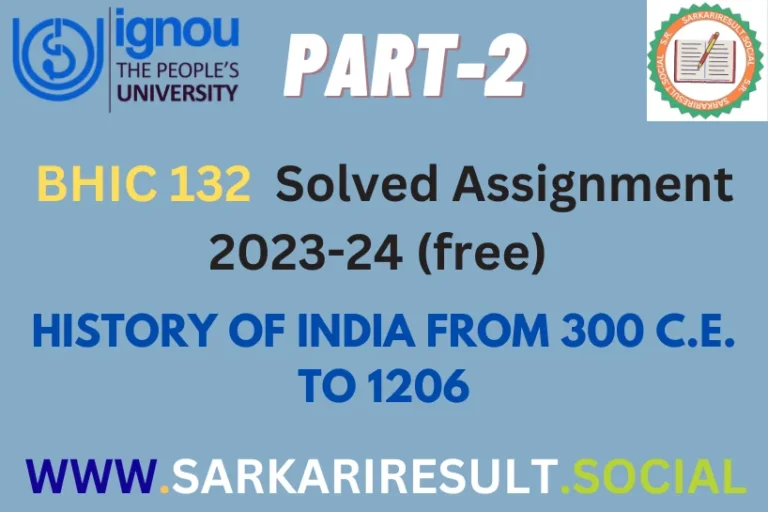BPSC 132 SOLVED IGNOU ASSIGNMENT FREE PART 2
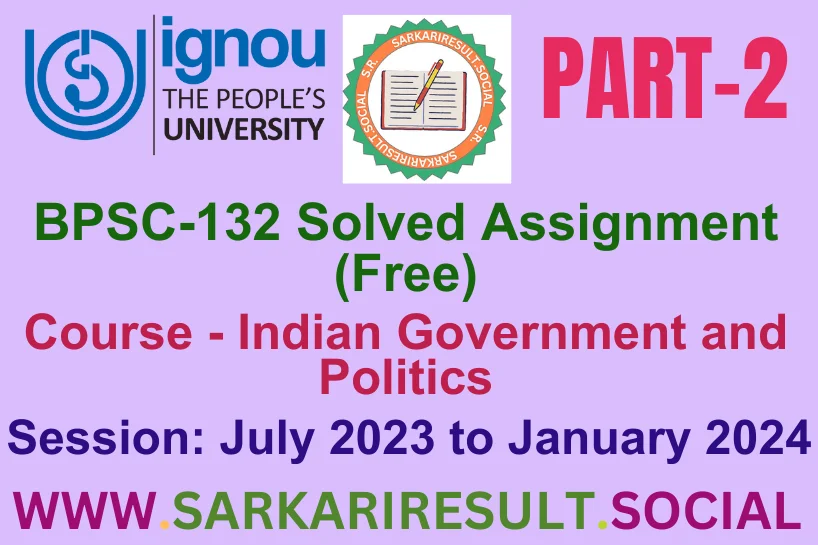
Welcome to the BPSC 132 SOLVED IGNOU ASSIGNMENT FREE PART 2 TMA. Assignment – II streamlines your approach with concise answers to three pivotal questions. In about 250 words each, discuss the special powers and functions of the Rajya Sabha, explain the procedure for removing a judge of the Supreme Court, and examine Parliament’s powers to amend the Constitution of India. Our short and focused responses provide a straightforward path for grasping these critical aspects of Indian government and politics, ensuring a smooth and successful completion of your assignments.
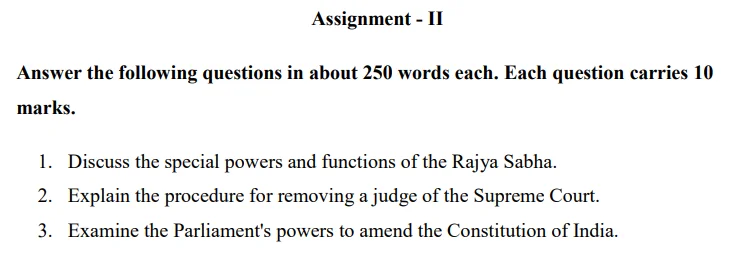
Answer the following questions in about 250 words each. Each question carries 10 marks.
Q.1 Discuss the special powers and functions of the Rajya Sabha.
Ans. The Rajya Sabha, the upper house of the Indian Parliament, holds distinct powers and functions that contribute to the legislative process, representation, and the federal structure of India.
Special Powers:
1. Equal Representation of States:
– The Rajya Sabha represents the states and union territories, providing a federal character to the legislative process. Members are not directly elected by the people but are elected by the elected members of the State Legislative Assemblies and Electoral College of Union Territories.
2. Representation of Knowledge and Expertise:
– The President has the power to nominate members with special knowledge or practical experience in literature, science, art, and social service. This ensures a diverse pool of expertise.
3. Representation of Anglo-Indian Community:
– The President can nominate two members from the Anglo-Indian community if it feels they are not adequately represented.
4. Limitation on Dissolution:
– The Rajya Sabha is a permanent body and is not subject to dissolution. One-third of its members retire every two years, providing continuity and stability.
5. Approval of National Emergency:
– The Rajya Sabha plays a crucial role in the declaration of a national emergency. It can only be approved with a special majority, ensuring a more comprehensive review.
6. Power to Initiate and Pass Certain Bills:
– While the Lok Sabha has the primary role in money matters, the Rajya Sabha can initiate and pass non-money bills. It serves as a revising chamber.
Functions:
1. Legislative Functions:
– The Rajya Sabha participates in the law-making process by reviewing and suggesting amendments to bills. While money bills can only be introduced in the Lok Sabha, other bills can be initiated in either house.
2. Representation of States:
– It ensures the representation of states and union territories in the central legislature, providing a forum for their concerns and interests.
3. Scrutiny of Executive Actions:
– The Rajya Sabha can question and scrutinize the policies and actions of the executive through debates, questions, and committee reports.
4. Role in Constitutional Amendments:
– Certain constitutional amendments require a special majority that includes the support of both houses. The Rajya Sabha, being part of the Parliament, is involved in the amendment process.
5. Impeachment Proceedings:
– The Rajya Sabha has the power to initiate impeachment proceedings against the President, Vice President, Judges of the Supreme Court and High Courts, and the removal of the Attorney General.
6. International Representation:
– Members of the Rajya Sabha represent India in various international forums and parliamentary associations.
In conclusion, the Rajya Sabha is a vital component of India’s parliamentary system, ensuring representation of states, expertise, and serving as a revising chamber in the legislative process. Its special powers contribute to the checks and balances in the Indian political system.
Q.2 Explain the procedure for removing a judge of the Supreme Court.
Ans. The removal of a judge of the Supreme Court in India is a meticulous and constitutional process aimed at ensuring judicial independence while holding judges accountable for misconduct or incapacity. The procedure is outlined in Article 124(4) of the Indian Constitution.
Procedure for Removal:
1. Initiation of the Process:
– A removal motion can be initiated in either house of Parliament (Lok Sabha or Rajya Sabha) by a minimum of 100 members in Lok Sabha or 50 members in Rajya Sabha.
2. Formulation of the Charge:
– The motion must contain specific charges of misbehavior or incapacity against the judge. It is crucial to present clear and substantiated allegations.
3. Submission to the Speaker/Chairman:
– The removal motion is submitted to the Speaker of the Lok Sabha or the Chairman of the Rajya Sabha, depending on the house where it is initiated.
4. Examination by Speaker/Chairman:
– The Speaker/Chairman may admit the motion if it meets the constitutional requirements. If they find it in order, they form a three-member committee to investigate the charges.
5. Investigation Committee:
– The committee comprises the Chief Justice of India, a judge of the Supreme Court, and a distinguished jurist. This committee investigates the charges and submits a report to the Speaker/Chairman.
6. Decision by Parliament:
– Based on the committee’s report, the motion is placed before the house where it was initiated. A special majority is required for the motion to be successful – a majority of the total membership of that house and a majority of not less than two-thirds of the members present and voting.
7. Passage in Both Houses:
– If the motion is accepted by the house where it originated, it is sent to the other house, which must also pass it by a similar majority.
8. Presidential Approval:
– After approval in both houses, the motion is presented to the President for approval. The President can then issue an order removing the judge.
The procedure is designed to be rigorous, ensuring that the removal of a judge is not arbitrary and is based on substantial evidence of misbehavior or incapacity. This safeguards the independence of the judiciary while holding judges accountable for any serious lapses.
Q.3 Examine the Parliament’s powers to amend the Constitution of India.
Ans. The power to amend the Constitution of India is vested in the Parliament under Article 368. However, this power is not absolute; it is subject to certain limitations and procedures to safeguard the basic structure of the Constitution.
Powers to Amend:
1. Initiation by Parliament:
– Amendments can be initiated only by Parliament. No external authority, including the President, has the power to propose amendments.
2. Special Majority:
– A constitutional amendment requires a special majority, which is defined as a majority of the total membership of each house and a majority of not less than two-thirds of the members present and voting.
3. Ratification by States:
– In certain cases, if an amendment relates to federalism or subjects mentioned in Article 1 or the First Schedule, it requires ratification by the legislatures of not less than one-half of the states.
4. No Presidential Veto:
– Unlike some other countries, the President has no veto power over constitutional amendments. Once both houses of Parliament pass an amendment with the required majority, it is presented to the President for assent, and it becomes law.
Limitations:
1. Basic Structure Doctrine:
– The Supreme Court, through various judgments, has established the Basic Structure Doctrine, asserting that while Parliament has the power to amend the Constitution, it cannot alter its basic structure. This ensures that fundamental principles like democracy, rule of law, and judicial review remain intact.
2. Federal Character:
– Certain amendments that affect the federal structure or the distribution of powers between the center and states require ratification by state legislatures.
3. Judicial Review:
– The power to amend is not a carte blanche. The Supreme Court has the authority to review amendments and strike them down if they violate the basic structure or other provisions of the Constitution.
4. Limitation on Amendment Procedure:
– The amendment procedure itself, as specified in Article 368, cannot be amended. This ensures that the process for amending the Constitution remains stable.
In conclusion, while Parliament holds significant powers to amend the Constitution, these powers are circumscribed by the principles of the Basic Structure Doctrine, federalism, and the essential features of the Constitution. This balance ensures flexibility for necessary changes while protecting the core values of the Indian Constitution.
Also See This: BPSC 132 SOLVED IGNOU ASSIGNMENT FREE PART 3

